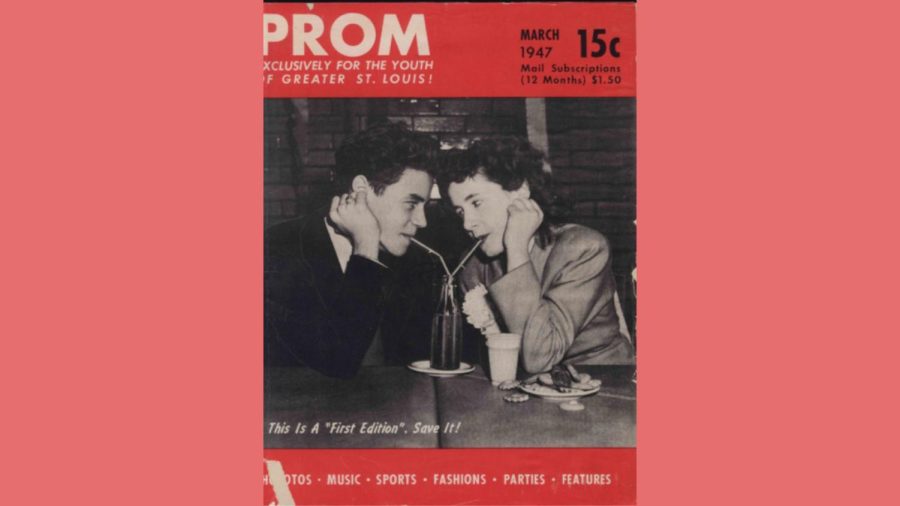The Rabbi’s son who created ‘Prom’ magazine and St. Louis’ fascination for where we went to high school
This cover from the first issue of Prom features a teen couple typical of those in the magazine. Missouri Historical Society Collections
Published June 26, 2023
Before Facebook, Instagram, Twitter, TikTok, and other social media platforms existed, teens in St. Louis shared their social and school activities through Prom magazine. It claimed to be the only publication in the country published exclusively for the youth of the community.
The monthly magazine was the brainchild of Julian H. Miller, Jr., a former advertising executive with Olian Advertising Company. Born in Chattanooga, Tennessee, in 1915, Miller moved to St. Louis with his family in 1919 when his father became the rabbi for Congregation B’nai El which was located in south St. Louis City at 3666 Flad. Rabbi Miller served the Congregation until 1956 and died in 1961.
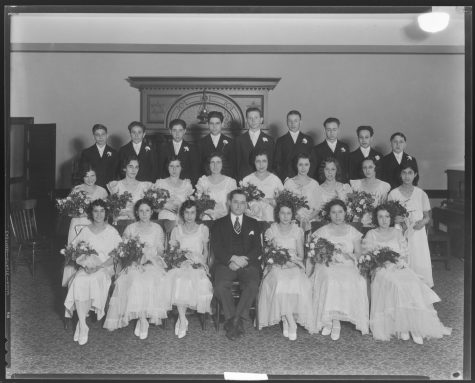
Julian H. Miller, Jr.
In the late 1920s, Rabbi Miller was reported to have been such a good friend of Sam Koplar, that when Koplar lost the Park Plaza during the Depression, Miller help secure enough donations to enable him to buy it back. In gratitude, Miller, Jr. lived rent-free at the Chase Hotel for years.
ADVERTISEMENT
From the Chase Hotel, Miller Prom magazine which featured “photographs of the dances, parties, sports and fashions at the public, private and parochial schools of this area.” It also included a column written by students from each school.
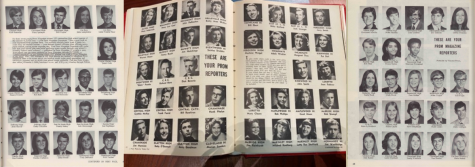
Being a Prom reporter was a coveted role. Informal interviews with former reporters revealed what a special assignment it was, though none could remember how they were selected.
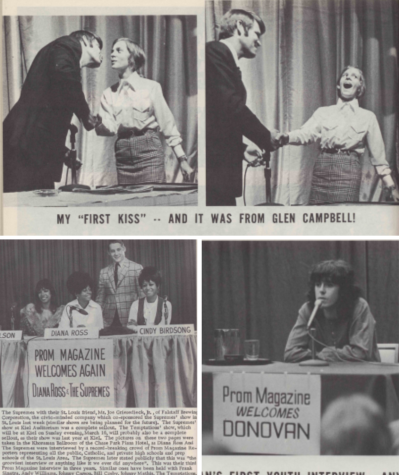
Young reporters were able to attend in-person interview sessions with singers and entertainers who were in town on tour. Some celebrities even gave Prom staff autographed pictures. These events were often held at the Chase Park Plaza Hotel where the young reporters had a chance to mingle with their cohorts from other schools.
Prom Magazine
ADVERTISEMENT
Though advertised as unique to St. Louis, “sister” publications were published in a number of other cities including Kansas City, Missouri; Rochester, New York; Cincinnati, Columbus; and Dayton, Ohio. Some of these magazines lasted many years, but none as long as St. Louis’ “Prom,” which was published from 1947 to 1973.
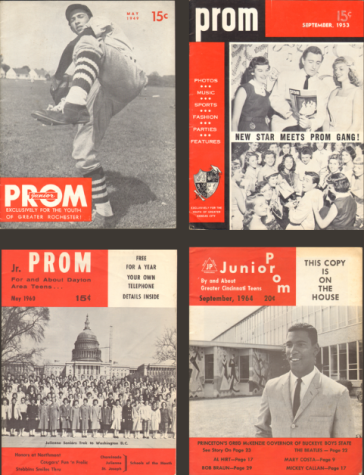
Miller recognized that advertising revenues, not subscription fees, would primarily fund this enterprise. Department stores took full-page, and sometimes, multi-page ads directed at teens that featured students and Prom reporters.
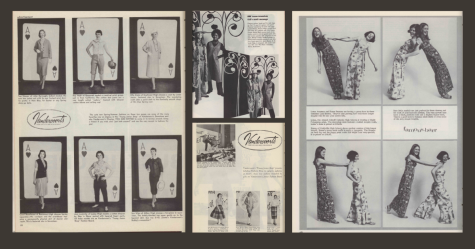
Employers and post-secondary schools also placed ads in Prom hoping to attract employees and future students.
In keeping with Miller’s focus on best serving young people, the magazine didn’t publish advertisements for alcoholic beverages or cigarettes. However, in the late 1960s, Falstaff Brewing Company was able to run several multi-page ads touting the many concerts and events it was sponsoring.
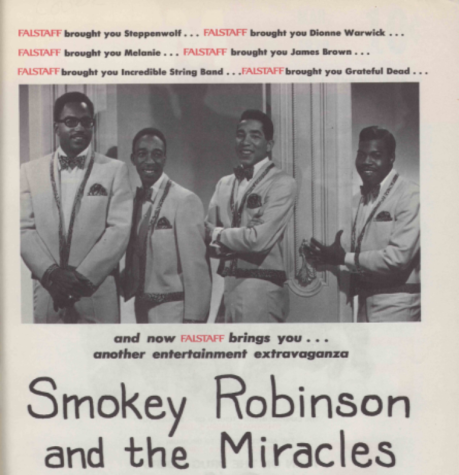
Initially, Prom was priced at $.15/issue or $1.50 for a 12-month mailed subscription (the same price as Life Magazine at that time). Advertising revenues must have been good because by the 1950s, prices had dropped to $.10/issue or a yearly subscription for $1.00. (Life Magazine’s price continued to rise, however. By the 1960s, a single issue cost $.35.)
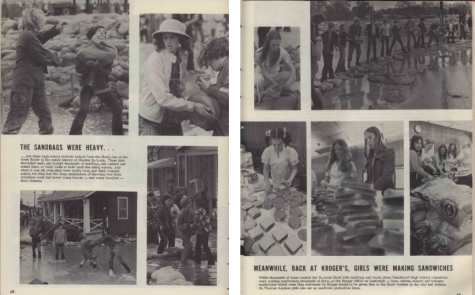
However, attention to diverse groups was lacking. The absence of minorities in the images in this post is representative of the coverage they were given in the publication. Outside of being included in group shots of athletic teams and cheerleading squads, small consideration was given to racial equity.
Prom’s first issue, March 1947, included 52 pages with columns from 29 schools. By November 1969 it had grown to 120 pages with 53 pages of advertising. The magazine boasted that it was read “by 92.5% of all local area high school students.” In the late 1960s, 76 schools were submitting monthly updates. Then things changed.
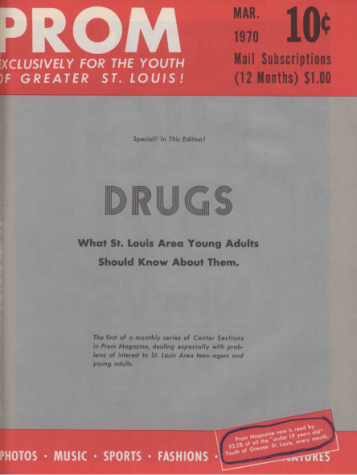
Starting with its 23rd-year anniversary issue, March 1970, Miller began devoting issue after issue to the ills of drug addiction, especially its impact on teens, his prime customer base. In a June 4, 1983, letter to the Missouri Historical Society, he acknowledged that as he launched his Anti-Drug Abuse Foundation, “Prom: issues became more sporadic. Only seven issues were published in 1970 – two in 1971, three in 1972, and just one in 1973.
Perhaps the heavy tone of this anti-drug coverage and the attendant absence of upbeat local high school news eroded interest in the magazine and led to its eventual decline. After nearly 300 editions, “Prom” magazine published its final edition in July 1973.
If you’d like to relive what was going on when you were in high school, visit the Missouri Historical Society’s Library & Research Center on Skinker Boulevard to explore the collection of every issue of Prom magazine.
I did and was surprised to learn that a grad school roommate who became my attorney and is still a close friend was a Prom reporter at Maplewood-Richmond Heights High School. I was even more surprised to find a picture of my law school roommate dancing in drag at Southwest High School. But the image I enjoyed the most was one of my older brother Stuart (second from the left in the image below) participating in a tug of war at Tilles Park.
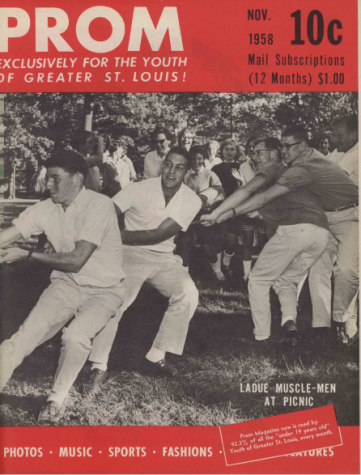
Special thanks to Rene Jones in the Rare Books and Manuscripts department of the St. Louis Public Library, John Sebben of St. Louis Classic Rock, and especially Jason Stratman and his team at the Library & Research Center for their support and assistance in pulling this together.



